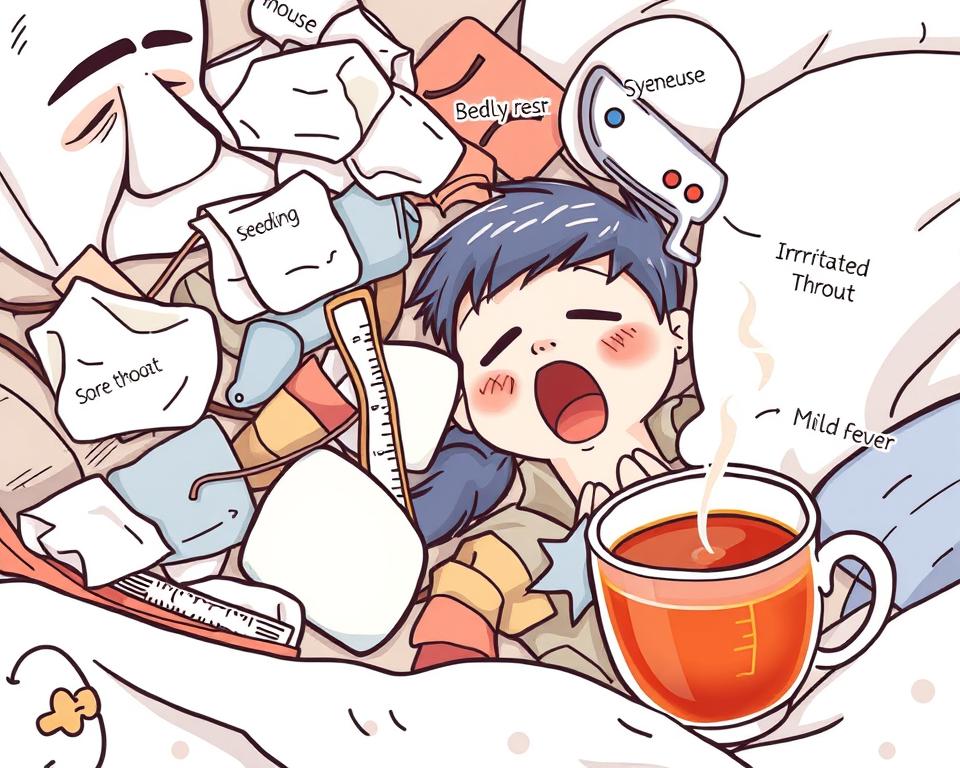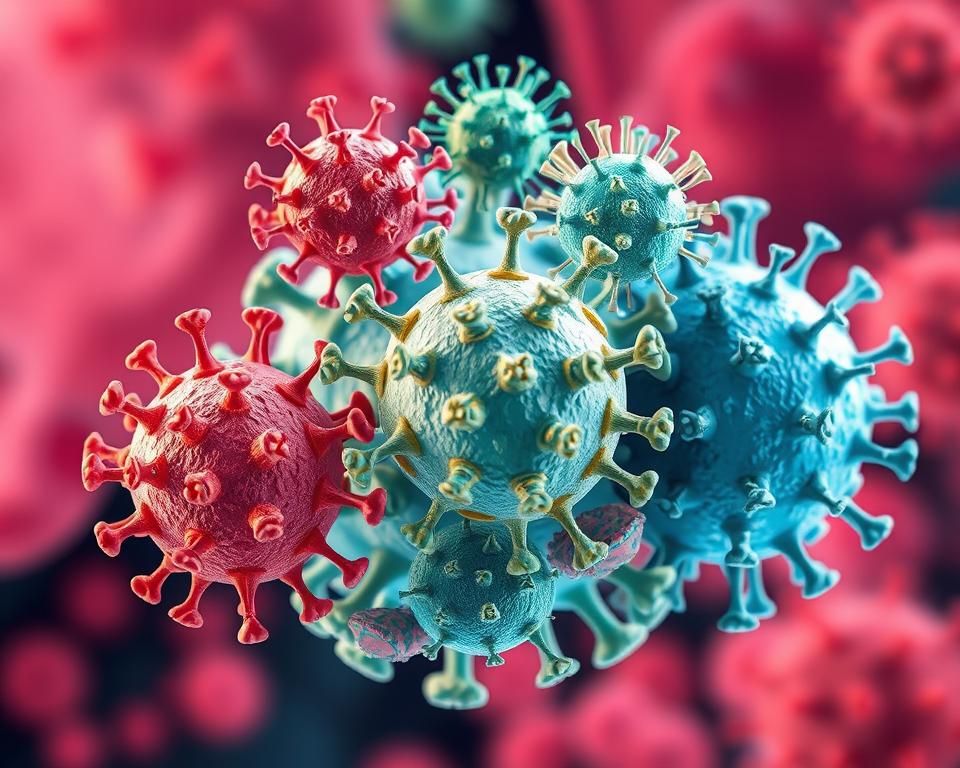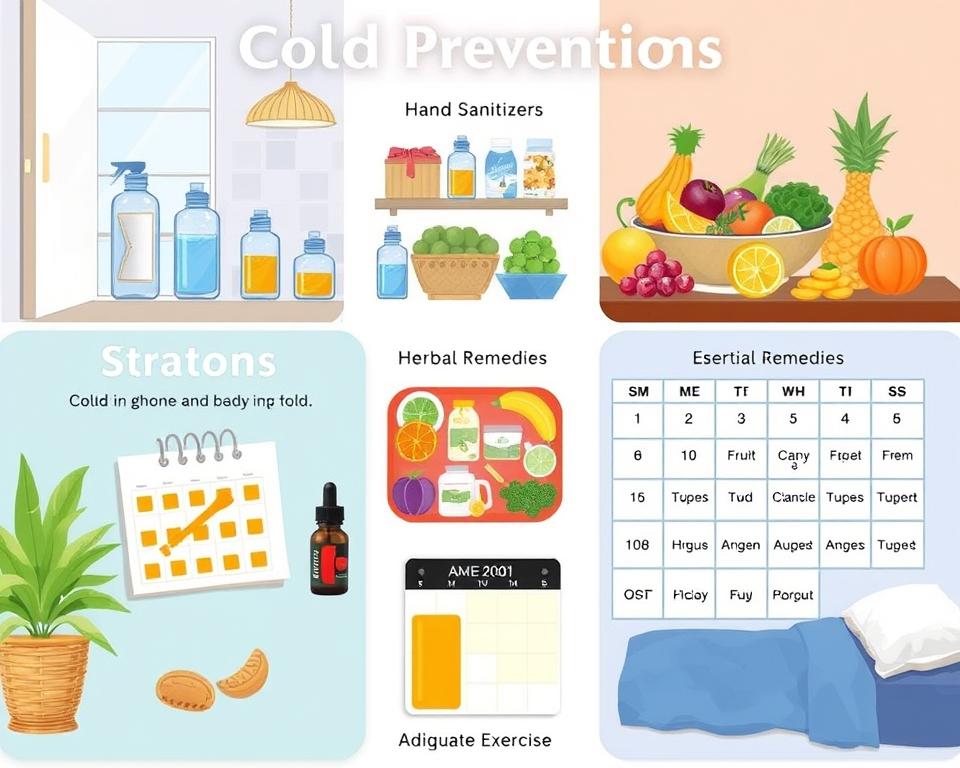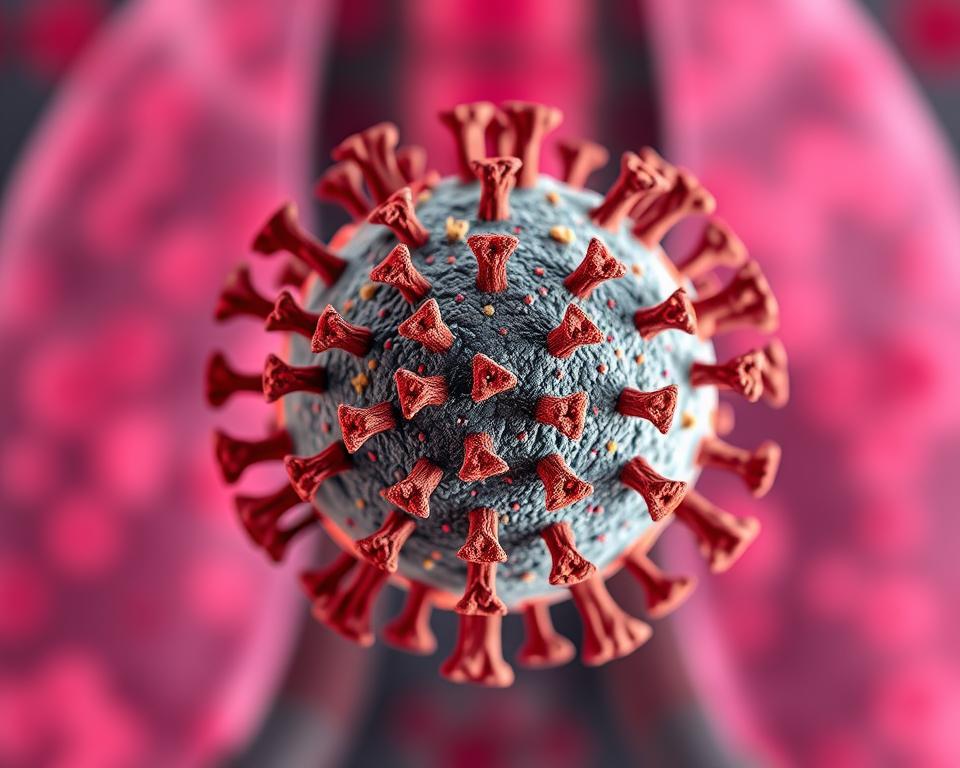The common cold is a widespread viral infection that affects millions of Americans each year. This respiratory illness targets the upper airways, causing discomfort and a range of recognizable symptoms. Despite its prevalence, many people still have questions about this pesky health issue.
Colds are caused by various viruses, with rhinoviruses being the most frequent culprits. These tiny invaders enter the body through the nose or mouth, triggering an immune response that leads to the classic cold symptoms. While often mild, colds can disrupt daily life and sometimes lead to more serious complications.
Understanding the common cold is crucial for effective management and prevention. From recognizing early signs to knowing when to seek medical help, being informed about this viral infection can help individuals navigate cold season with greater ease and confidence.
Key Takeaways
- The common cold is a viral infection affecting the upper respiratory tract
- Rhinoviruses are the most common cause of colds
- Symptoms typically include runny nose, sore throat, and cough
- Colds are highly contagious and spread through air and contact
- Most colds resolve on their own within 7-10 days
- Prevention includes good hygiene and boosting immune health
Definition and Overview of the Common Cold
The common cold is a viral infection that affects the upper respiratory tract. It’s one of the most frequent illnesses people experience worldwide. Colds can occur at any time but are more common during certain seasons.
Symptoms of the Common Cold
Cold symptoms typically develop gradually. The most common signs include:
- Runny or stuffy nose (congestion)
- Sore throat
- Cough
- Mild fever (less common in adults)
- Fatigue

Cold vs. Flu
While colds and flu share some symptoms, they are different illnesses. Flu symptoms often come on suddenly and are more severe. Fever is more common with flu, and body aches are usually more intense.
How Long Do Cold Symptoms Last?
Most people recover from a cold within 7-10 days. Symptoms peak around day 3 or 4. Congestion and cough may linger for up to two weeks. If symptoms persist longer or worsen, it’s best to consult a healthcare provider.
“Rest and staying hydrated are key to recovering from a cold. Over-the-counter medications can help manage symptoms, but they won’t cure the virus.”
Understanding the common cold helps in managing symptoms effectively and knowing when to seek medical attention. Remember, antibiotics don’t work against cold viruses, so focus on symptom relief and rest.
Causes of the Common Cold
Understanding the causes of the common cold is crucial for managing this widespread respiratory illness. The common cold is a viral infection that affects millions of people each year, leading to various symptoms and discomfort.
Viruses Behind the Cold
Rhinoviruses are the primary culprits behind most colds. These tiny invaders account for up to 50% of all colds. Other viruses that cause colds include coronaviruses, respiratory syncytial virus (RSV), and parainfluenza viruses. Each virus can trigger similar symptoms, making it challenging to pinpoint the exact cause without specific testing.

How Cold Viruses Spread
Cold viruses spread through various means, making them highly contagious. The main modes of transmission include:
- Airborne droplets: When an infected person coughs or sneezes, they release virus-laden droplets into the air.
- Direct contact: Touching an infected person’s hands or skin can transfer the virus.
- Surface contact: Viruses can survive on surfaces for hours, allowing people to pick them up by touching contaminated objects.
To reduce the risk of catching a cold, practice good hygiene habits like frequent handwashing and avoiding close contact with infected individuals. By understanding how these viral infections spread, you can take steps to protect yourself and others from this common respiratory illness.
Risk Factors for Developing a Cold
Understanding what makes you more likely to catch a cold can help with prevention and treatment. Several factors play a role in your susceptibility to these pesky viruses.
Age and Health Factors
Your age and overall health significantly impact your chances of getting sick. Young children often catch colds more frequently as their immune systems are still developing. Older adults may also face increased risks due to weakened immune responses.
- Infants and toddlers: 6-8 colds per year
- School-age children: 4-6 colds per year
- Adults: 2-3 colds per year
People with chronic health conditions or compromised immune systems are more susceptible to colds. Stress, lack of sleep, and poor nutrition can weaken your body’s defenses, making prevention more challenging.

Seasonal Influences on Cold Incidence
Cold viruses thrive in certain conditions, leading to seasonal patterns in infection rates. Fall and winter see higher numbers of colds due to factors like:
- Dry air indoors and outdoors
- More time spent in close quarters
- Reduced vitamin D from less sunlight
While colds can occur year-round, these seasonal influences make effective prevention strategies crucial during colder months. Understanding these risk factors can help you take proactive steps in cold prevention and seek appropriate treatment when necessary.
Prevention Strategies for the Common Cold
Staying healthy and avoiding the common cold is easier than you might think. By adopting simple prevention strategies, you can reduce your risk of catching this pesky virus. Let’s explore some effective methods to keep colds at bay.
Hygiene Practices to Reduce Infection Risk
Good hygiene is your first line of defense against colds. Wash your hands frequently with soap and water for at least 20 seconds. This simple act can significantly lower your chances of getting sick. Avoid touching your face, especially your nose, mouth, and eyes, as these are entry points for viruses.
Keep your surroundings clean. Regularly disinfect commonly touched surfaces like doorknobs, keyboards, and phones. If someone in your household has a cold, consider using separate towels and utensils to prevent the spread of germs.
Importance of Vaccination
While there’s no vaccine for the common cold, getting your annual flu shot can help. Many people mistake flu symptoms for a cold. By protecting yourself against the flu, you’re indirectly reducing your chances of experiencing cold-like symptoms.
Remember, prevention is always better than treatment. By following these strategies, you can boost your chances of staying healthy throughout the cold season. If you do catch a cold, rest assured that there are plenty of treatment options available to help you feel better quickly.
Treatment Options for the Common Cold
When you’re feeling under the weather, finding relief from cold symptoms is a top priority. Let’s explore effective ways to manage your cold and get back to feeling your best.
Over-the-Counter Remedies
Pharmacy shelves offer a variety of options for cold symptom relief. Decongestants can help ease nasal congestion, while cough suppressants provide relief from persistent coughing. For sore throat discomfort, look for lozenges or sprays with numbing agents.

Pain relievers like acetaminophen or ibuprofen can reduce fever and alleviate body aches. Remember to read labels carefully and follow dosage instructions to ensure safe and effective treatment.
Home Remedies and Natural Treatments
Many people find comfort in natural remedies for cold symptoms. Honey mixed with warm water or tea can soothe a sore throat and calm coughing. Gargling with salt water may provide temporary relief for throat irritation.
Stay hydrated by drinking plenty of fluids, which helps thin mucus and ease congestion. A warm compress applied to your sinuses can alleviate pressure and promote drainage. Rest is crucial for recovery, so make sure to get plenty of sleep.
“Let food be thy medicine and medicine be thy food.” – Hippocrates
While there’s no cure for the common cold, these treatment options can help manage symptoms and support your body’s natural healing process. If symptoms persist or worsen, consult your healthcare provider for personalized advice.
Complications of the Common Cold
While most colds resolve on their own, some can lead to more serious health issues. Understanding potential complications and knowing when to seek medical help is crucial for managing your health during a viral infection.
Secondary Infections
A common cold can sometimes pave the way for secondary infections. These occur when the initial viral infection weakens the immune system, allowing bacteria to thrive. Some common secondary infections include:
- Sinusitis: Inflammation of the sinuses
- Bronchitis: Inflammation of the bronchial tubes
- Ear infections: Often seen in children
These conditions can turn a mild respiratory illness into a more severe health problem. If you notice worsening symptoms or new signs of infection, it’s important to consult a healthcare provider.
When to Seek Medical Advice
Most colds don’t require a doctor’s visit. But certain symptoms warrant medical attention. Seek help if you experience:
- Fever above 101.3°F (38.5°C) lasting more than three days
- Difficulty breathing or chest pain
- Severe sinus pain
- Symptoms lasting more than 10 days
These signs could indicate a more serious condition or a complication from your cold. Don’t hesitate to reach out to a healthcare professional if you’re concerned about your symptoms.
The Common Cold in Children
Children are more prone to catching colds than adults. Their immune systems are still developing, making them vulnerable to various viruses. Understanding how colds affect kids and knowing the right treatment approaches can help parents manage their child’s symptoms effectively.
Unique Symptoms in Kids
While cold symptoms in children are similar to those in adults, some signs are more common in younger patients:
- Fussiness and irritability
- Decreased appetite
- Difficulty sleeping
- Swollen lymph nodes
Kids might also experience fever, which is less common in adult colds. If a child’s temperature rises above 100.4°F (38°C), it’s crucial to monitor them closely.
Caring for a Child with a Cold
Parents can take several steps to ease their child’s discomfort and speed up recovery:
- Ensure plenty of rest and fluids
- Use saline drops to clear nasal congestion
- Run a cool-mist humidifier in the child’s room
- Offer warm soup or tea for sore throats
For fever and pain, acetaminophen or ibuprofen can be used under a doctor’s guidance. Avoid giving aspirin to children, as it can cause serious complications.
“Prevention is key. Teach kids proper hand-washing techniques and keep them away from sick individuals to reduce their chances of catching a cold.”
If symptoms persist or worsen after a week, or if a child shows signs of difficulty breathing, seek medical attention promptly. Remember, antibiotics don’t work against cold viruses, so focus on symptom relief and supporting the body’s natural healing process.
The Common Cold: Myths and Misconceptions
The common cold has been around for centuries, yet many myths persist about its prevention and treatment. Let’s clear the air on some widespread misconceptions that might be affecting your approach to dealing with this pesky virus.
Debunking Common Cold Myths
Contrary to popular belief, cold weather doesn’t directly cause colds. Viruses are the real culprits. Vitamin C, while beneficial for overall health, doesn’t prevent colds as many think. Antibiotics, effective against bacteria, won’t help with viral infections like colds.
Understanding the Limitations of Treatment Options
When it comes to treatment, there’s no magic cure for the common cold. Over-the-counter medicines can ease symptoms but won’t speed up recovery. Rest and hydration remain key components of effective cold management. Knowing these limits helps set realistic expectations for prevention and treatment strategies.
By understanding the facts, you can make informed decisions about cold prevention and care. Focus on proven methods like hand washing and avoiding close contact with sick individuals. Remember, while we can’t completely avoid colds, we can take steps to reduce their impact on our lives.















Leave a Reply